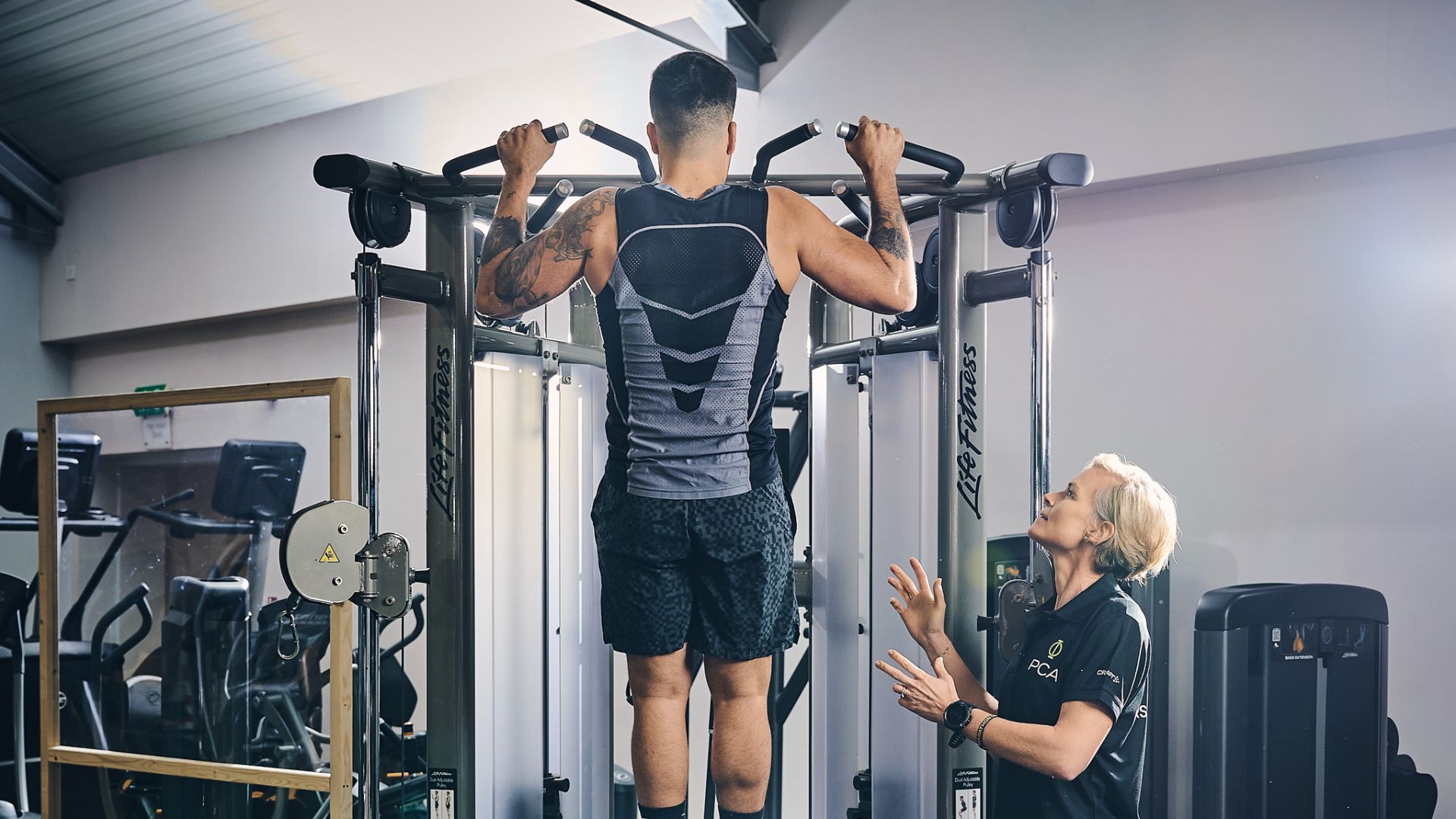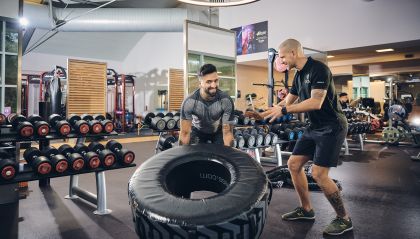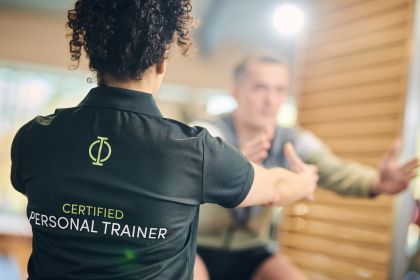Whether you can already knock a few out pull-ups, or you’ve never even successfully done one, check out these practical training tips to help you get better at pull-ups.
TIPS FOR GETTING BETTER AT PULL-UPS
Tip #1: Practice the move: The principle of specificity states that the body will adapt to the specific demands that are placed on it. This means that the best way to get better at pull-ups is to…do pull-ups. Consistent, intentional training is the key to improving your ability to perform this move.
Tip #2: Practice 2-4 times per week: It takes more than one day per week of intentional training to improve this move. Start with 2 days per week, spaced out, and slowly add additional days as you can. Some soreness is expected when you first start training, so give your muscles 1-2 days to recover!
Tip #3: Use slow and steady progressions: A good rule of thumb is the 2 for 2 rule when it comes to progressions. If you can do 2 extra reps (beyond the number of reps you’re shooting for) with good form for 2 sets in a row, then it’s time to move on to the next progression. Good form is the goal!
Tip #4: Incorporate strength training for your back muscles into your workout routine. In addition to practicing pull-up variations, it will really help you to include other back strengthening exercises like rows, lat pull downs, etc.
In case you’re curious, the difference between a pull-up and a chin-up is the hand position. Pull-ups use an overhand grip, and chin-ups use an underhand grip (which makes them easier since the biceps can help more with the movement). This article will focus on pull-ups, although the same tips can be applied toward performing chin-ups.
PULL-UP IMPROVEMENT WORKOUT ROUTINE
Set a goal for the number of pull-ups you’d like to perform (I recommend starting with a goal of 5-10 if you’re just starting out). If you can already perform pull-ups, you can use some of the movements below to perfect your technique and strengthen any weak links.
No matter where you’re starting out, I recommend starting with the following foundational movements to ensure proper stabilization and movement of the scapula (shoulder blades) during pull-ups. You’ll want to perform 1-3 sets of these exercises, starting with just 1 when you’re beginning.
These exercises don’t have to be done all at once. Choose 1 foundational and 1-2 strength building exercises to incorporate into your normal strength training routine each day that you train. When you are first starting out, begin by incorporating dead hangs and suspension trainer rows. Once you’ve mastered these moves, you can move on to the next progression. Keep progressing until you’re practicing actual pull-ups!
Pull-up progression exercises (in order of difficulty):
FOUNDATIONAL EXERCISES FOR DEVELOPING PULLUPS
Dead hang:
• Hold onto a bar with an overhand grip and drop your shoulders away from your ears.
• Keep your abs and glutes tight and hold this position for up to 1 minute. You can start with 10-20 seconds and build from there.
Dead hang with scapular pull-ups:
• Start in the dead hang position.
• Slowly let your shoulders relax, letting them rise toward the ears, and then drop the shoulders down and hold that position for two seconds.
• Repeat for 10 reps. You will feel the muscles around the shoulder blades working during this move.
STRENGTH BUILDING EXERCISES FOR PULLUP DEVELOPMENT
Suspension trainer rows:
• Hold the handles of the suspension trainer with your palms facing inward.
• Step back until your arms are straight and there is tension in the straps.
• Lean back slightly and slowly walk your feet forward until your body is at about a 45-degree angle.
• Keep the shoulders down and body tight as you row yourself toward the anchor.
• Row your wrist toward your ribcage, then slowly lower down.
• Repeat for 10 reps. If it feels too easy, walk your feet forward. If it’s too hard, walk your feet backward.
Inverted rows:
• You can use a barbell or a suspension trainer for this move.
• You will be under the bar or anchor with your knees bent at 90 degrees (the straighter your legs, the harder the movement).
• Pull your body straight up, keeping the shoulders down, and squeezing the shoulder blades together. Row the wrists toward the ribcage.
• Slowly lower down, and repeat for 10 reps.
Suspension trainer pull-ups:
• Shorten the straps so that when you are seated underneath the anchor, your arms are fully extended as you hold the straps.
• Pull up just like you would for a pull-up. You can use as much or as little of a boost from your legs as needed. Over time decrease the help from your legs until your upper body is doing most of the movement.
• This move can be performed with a barbell anchored at the right height.
• Repeat for 10 reps.
Hop up, slow down pull-ups (i.e., Negatives):
• Place a box beneath the bar and stand on it while holding the bar with an overhand grip.
• Hop up to the top position of the pull-up, drop the shoulders down, and steady your body.
• Hold for two seconds before slowly lowering down until your arms are straight (the bottom position of the pull-up). This should take no less than 4 seconds.
• Get back on the box and repeat for 10 reps.
Band assisted pull-up:
• Anchor a resistance band (a loop band, the thicker the more support) at the bar, or low (as shown in the video). Place one foot in the loop gently and grasp the pull-up bar with the hands.
• Pack your shoulders down and back and slowly step into the resistance band until it is supporting your weight.
• Pull your chest up toward the bar, squeezing the shoulder blades together at the top. Lower down in a controlled manner until the arms are almost straight.
• Repeat for 10 reps.
WHAT OTHER EXERCISES HELP WITH PULL-UP STRENGTH?
In addition to practicing pull-ups, you can perform some of these other movements to increase your back strength to support your pull-up goals.
Lat pull-downs:
• Sit at the machine (see machine instructions for proper use and position as some machines vary).
• Grasp bar with overhand grip and drop your shoulders down and away from your ears.
• Lean back just slightly, about 15 degrees, keeping core tight and back straight.
• Pull the bar down toward the top of your chest, squeezing the shoulder blades together as you pull.
• Slowly return to the starting position.
Dumbbell rows:
• Place your right hand and knee on a bench for support.
• Keep your back flat, shoulders down, and core tight as you row the dumbbell up with your left hand.
• Row your wrist toward your ribcage, and lower in a controlled manner.
Barbell bent over rows:
• Hold the barbell with an overhand grip and hinge at the hips until your back is as close to parallel to the ground as you can get it.
• Keep your core tight and your head in a neutral position the entire time.
• Row the barball up toward your body and return to the starting position at a medium tempo.
Cable rows/seated rows:
• Sit facing the cable with good posture.
• Row the wrist toward the ribcage and squeeze between the shoulder blades as you row.
• Return to the starting position at a medium tempo.
WHAT MUSCLES DO YOU USE FOR PULL-UPS?
Pull-ups use the following muscles:
Latissimus dorsi, rhomboids, traps, posterior deltoids, brachialis, and muscles in the forearms. In addition, the core muscles stabilize and help keep the body stable during the movement.
THE BENEFITS OF CALISTHENICS
Calisthenics are bodyweight training exercises that may or may not use equipment (like a suspension trainer). Calisthenics are functional, help improve bone density, increase muscular strength and endurance, improve body composition, and they require no equipment, so they are easy to do anywhere!
Some examples of calisthenics are pull-ups (these require an object that you can pull yourself up on), push-ups, squats, bridging, planks, jumping jacks, mountain climbers, etc.
WHAT’S NEXT AFTER YOUR FIRST 10 PULL-UPS?
Congrats on getting your first 10 pull-ups! That’s no small feat. From there, you can decide where you want to go based on your goals. Do you want to continue to build your endurance (i.e., the number of reps you can do), or build your strength? If you choose to continue to build your endurance, just slowly add reps over time (1-2 reps every 1-2 weeks, depending on the volume you’re able to do) until you reach your desired rep goal.
If you choose to build your strength, you can add weight to your pull-ups by adding a weighted vest or hooking a weight to a belt that’s designed to hold weight. Similar to strength training periodization, consider how much you weigh and add 2-5% of that each time you increase weight. No matter which routes you choose, make sure you are able to keep good form for all reps!



